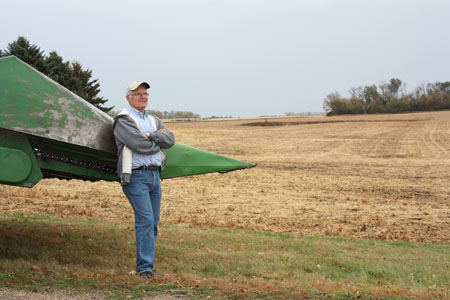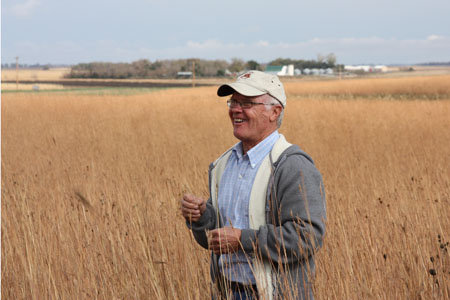Carmen Fernholz
Organic Farmer, Madison, Minnesota
Carmen grew up on a small farm with his parents and eight siblings just down the road from where he now owns and operates A-Frame Farms. A-Frame Farms is an organic operation he and his wife Sally started in 1972 with 80 acres. Today, the Fernholz’s raise certified organic small grains, corn and soybeans on around 360 tillable acres. Over the years Carmen has been recognized as a leader in the organic field and plays an important role in counseling farmers and others who are interested in this type of agriculture.
Conservation and water quality are important factors for how Carmen manages his farming operation, incorporating a wide variety of Best Management Practices (BMPs). On the Fernholz Farm a person will find a controlled flow tiling system that holds back water during drier periods and at higher flows it outlets into a wetland. This helps prevent excessive nutrients and sediment from reaching waterbodies like the Lac qui Parle River. In addition, he utilizes other BMPs like conservation tillage, terraces, and windbreaks. One of the proudest accomplishments for Carmen is his 100 plus acre Conservation Reserve Program (CRP) easement with its native grasses and large wetland.
Involvement in organic agriculture plays a major role in Carmen’s life and it has been this way since he started farming close to 40 years ago. His desire to learn more has led him to be involved with research projects through institutions like the Minnesota Southwest Research and Outreach Center and he works for the University of Minnesota Morris on local food issues. Carmen served a variety of boards including the Board of the Minnesota Institute for Sustainable Agriculture (MISA), the Lac qui Parle County Resource Commission, and the Lac qui Parle Lake Association.
On a walk through his prairie restoration, Carmen talked about the different grasses and forbs they planted. “I know some times during the summer if you have the right grass it really intrigues me on how it is taller than me. I sort of get that image of what the pioneer [experience] what 150, 200 years ago when they would get lost out in this grass. Then I come to find out how this grass really made the fertile soils here and it wasn’t the grass on top it was the roots below. How those things dying, regrowing built that black soil. We are reaping those benefits today. And of course in this set up having this sort of as a water purifier for this area of land because the water comes in here soaking in a lot.”


